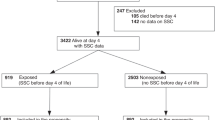Abstract
Background
Recent reports suggest a rising awareness of sudden unexpected postnatal collapse (SUPC).
Local problem
Five SUPC events during a 17-month period.
Methods
A multidisciplinary team used a quality-improvement approach to develop the intervention. The smart aim was to develop a bundled intervention to eliminate SUPC from occurring in the delivery room during skin-to-skin care.
Intervention
A bundled intervention included a standardized assessment tool and measurement of oxygen saturation levels, with prescribed responses to abnormal values, during skin-to-skin care in the delivery room.
Results
Pre-intervention, there were five SUPC events/9143 live births (incidence 0.54/1000 live births) compared with 0 SUPC events/13,964 live births post intervention, p = 0.011. Special cause variation was achieved after implementation when the number of deliveries between SUPC events exceeded 3-sigma.
Conclusion
A bundled approach to monitoring during skin-to-skin care, including measurement of oxygen saturation, was associated with no additional cases of SUPC.
This is a preview of subscription content, access via your institution
Access options
Subscribe to this journal
Receive 12 print issues and online access
$259.00 per year
only $21.58 per issue
Buy this article
- Purchase on Springer Link
- Instant access to full article PDF
Prices may be subject to local taxes which are calculated during checkout

Similar content being viewed by others
References
Poets A, Steinfeldt R, Poets CF. Sudden deaths and severe apparent life-threatening events in term infants within 24 h of birth. Pediatrics. 2011;127:e869–73.
Lehtonen L, Gimeno A, Parra-llorca A. Early neonatal death: a challenge worldwide. Semin Fetal Neonatal Med. 2017;22:153–60.
Ludington-Hoe SM, Morgan K. Infant assessment and reduction of sudden unexpected postnatal collapse risk during skin-to-skin contact. Newborn Infant Nurs Rev. 2014;14:28–33.
Feldman-Winter L, Goldsmith JP. Safe sleep and skin-to-skin care in the neonatal period for healthy term newborns. Pediatrics . 2016;138:e20161889.
Lutz TL, Elliott EJ, Jeffery HE. Sudden unexplained early neonatal death or collapse: a national surveillance study. Pediatr Res. 2016;80:493–8.
Pejovic NJ, Herlenius E. Unexpected collapse of healthy newborn infants: risk factors, supervision and hypothermia treatment. Acta Paediatr Int J Paediatr. 2013;102:680–8.
Becher J-C, Bhushan SS, Lyon AJ. Unexpected collapse in apparently healthy newborns--a prospective national study of a missing cohort of neonatal deaths and near-death events. Arch Dis Child Fetal Neonatal Ed. 2012;97:F30–34.
Andres V, Garcia P, Rimet Y, Nicaise C, Simeoni U. Apparent life-threatening events in presumably healthy newborns during early skin-to-skin contact. Pediatrics. 2011;127:e1073–1076.
Herlenius E, Kuhn P. Sudden unexpected postnatal collapse of newborn infants: a review of cases, definitions, risks, and preventive measures. Transl Stroke Res. 2013;4:236–47.
Thach BT. Deaths and near deaths of healthy newborn infants while bed sharing on maternity wards. J Perinatol. 2014;34:275–9.
Neuburger J, Walker K, Sherlaw-Johnson C, Van Der Meulen J, Cromwell DA. Comparison of control charts for monitoring clinical performance using binary data. BMJ Qual Saf. 2017;26:919–28.
Feldman-Winter L. Evidence-based interventions to support breastfeeding. Pediatr Clin North Am. 2013;60:169–87.
Policy Statement. Breastfeeding and the use of human milk. Pediatrics. 2012;129:e827–e841.
ACOG Committee Opinion. Optimizing support for breastfeeding as part of obstetric Practice. Committee opinion 756. Obstet Gynecol. 2018;132:e187–e196.
Meek JY, Noble L. Implementation of the ten steps to successful breastfeeding saves lives. JAMA Pediatr. 2016;170:925–6.
Bass JL, Gartley T, Kleinman R. Unintended consequences of current breastfeeding initiatives. JAMA Pediatr. 2016;170:923–4.
Garofalo NA, Pellerite M, Goodstein M, Paul DA, Hageman JR. Sudden unexpected postnatal collapse (SUPC): one neonatal death is one death too many. Current concepts. Neonatol Today. 2019;14:55–58.
Garofalo NA, Pellerite M, Goodstein M, Paul DA, Hageman JR. Sudden unexpected postnatal collapse (SUPC): one neonatal death is one too many Part 2: Collaborative Quality Initiatives. 2019;14:4–6.
Funding
The project was completed with no specific financial support.
Author information
Authors and Affiliations
Corresponding author
Ethics declarations
Conflict of interest
The authors declare that they have no conflict of interest.
Additional information
Publisher’s note: Springer Nature remains neutral with regard to jurisdictional claims in published maps and institutional affiliations.
Rights and permissions
About this article
Cite this article
Paul, D.A., Johnson, D., Goldstein, N.D. et al. Development of a single-center quality bundle to prevent sudden unexpected postnatal collapse. J Perinatol 39, 1008–1013 (2019). https://doi.org/10.1038/s41372-019-0393-y
Received:
Revised:
Accepted:
Published:
Issue Date:
DOI: https://doi.org/10.1038/s41372-019-0393-y



